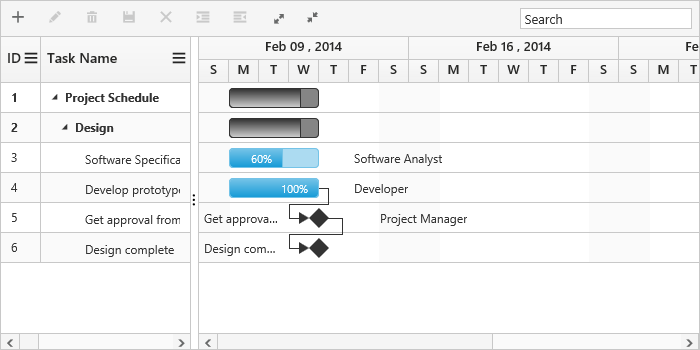Getting Started
9 Feb 201819 minutes to read
This section explains briefly about how to create a Gantt chart in your application with JavaScript.
Create your first Gantt in JavaScript
This tutorial explains about how to create a simple Gantt chart, add tasks or subtasks and set relationship between tasks during the design phase of a software project. The following screenshot displays the desired output after completing this tutorial.

Adding script references
Create an HTML file and add the following template to the HTML file.
<!DOCTYPE html>
<html xmlns="http://www.w3.org/1999/xhtml">
<head>
<title>Getting Started with Gantt Control for JavaScript</title>
<!-- style sheet for default theme(flat azure) -->
<link href="http://cdn.syncfusion.com/28.1.33/js/web/flat-azure/ej.web.all.min.css" rel="stylesheet" />
<!--scripts-->
<script src="http://cdn.syncfusion.com/js/assets/external/jquery-1.10.2.min.js"></script>
<script src="http://cdn.syncfusion.com/js/assets/external/jsrender.min.js"></script>
<script src="http://cdn.syncfusion.com/js/assets/external/jquery.globalize.min.js"></script>
<script src="http://cdn.syncfusion.com/js/assets/external/jquery.easing.1.3.min.js"></script>
<script src="http://cdn.syncfusion.com/28.1.33/js/web/ej.web.all.min.js "></script>
</head>
<body>
<!--Add Gantt control here-->
</body>
</html>Binding Gantt with data
Create data source for ejGantt.
var data = [{
taskID: 1,
taskName: "Design",
startDate: "02/10/2014",
endDate: "02/14/2014",
duration: 6,
subtasks: [
{
taskID: 2,
taskName: "Software Specification",
startDate: "02/10/2014",
endDate: "02/12/2014",
duration: 4,
progress: "60",
resourceId: [2]
},
{
taskID: 3,
taskName: "Develop prototype",
startDate: "02/10/2014",
endDate: "02/12/2014",
duration: 4,
progress: "70",
resourceId: [3]
},
{
taskID: 4,
taskName: "Get approval from customer",
startDate: "02/12/2014",
endDate: "02/14/2014",
duration: 2,
progress: "80",
predecessor: "3FS",
resourceId: [1]
},
{
taskID: 5,
taskName: "Design complete",
startDate: "02/14/2014",
endDate: "02/14/2014",
duration: 0,
predecessor: "4FS"
}
]
}];Initialize Gantt
Add a <div> element with in the <Body> tag.
<body>
<!--Add Gantt control here-->
<div id="GanttContainer"></div>
</body>Initialize the Gantt with data source created in the last step. To render Gantt tasks we need to set the value for taskIdMapping, taskNameMapping, startDateMapping, endDateMapping/durationMapping, progressMapping, childMapping properties.
$(function() {
$("#GanttContainer").ejGantt({
dataSource: data, //Provides data source for Gantt
taskIdMapping: "taskID", //Provide name of the property which contains task id in the data source
taskNameMapping: "taskName", //Provide name of the property which contains task name in the data source
scheduleStartDate: "02/01/2014", //Provide schedule header start date
scheduleEndDate: "03/14/2014", //Provide schedule header end date
startDateMapping: "startDate", //Provide name of the property which contains start date of the task in the data source
durationMapping: "duration", //Provide name of the property which contains duration of the task in the data source
progressMapping: "progress", //Provide name of the property which contains progress of the task in the data source
childMapping: "subtasks", //Provide name of the property which contains subtask of the task in the data source
});
});A Gantt chart is created as shown in the following screen shot.

Enable Toolbar
Gantt control contains toolbar options to edit, search, expand or collapse all records, indent, outdent, delete and add a task. You can enable toolbar using the toolbarSettings property.
$("#GanttContainer").ejGantt({
toolbarSettings: {
showToolbar: true,
toolbarItems: [
ej.Gantt.ToolbarItems.Add,
ej.Gantt.ToolbarItems.Edit,
ej.Gantt.ToolbarItems.Delete,
ej.Gantt.ToolbarItems.Update,
ej.Gantt.ToolbarItems.Cancel,
ej.Gantt.ToolbarItems.Indent,
ej.Gantt.ToolbarItems.Outdent,
ej.Gantt.ToolbarItems.ExpandAll,
ej.Gantt.ToolbarItems.CollapseAll,
ej.Gantt.ToolbarItems.Search
],
}
});The following screen shot displays a Tool bar in Gantt control:

NOTE
Add, edit and delete options are enabled when enabling the
allowEditing,allowAddingandallowDeletingproperties in the edit options.
Enable Sorting
The Gantt control has sorting functionality to arrange the tasks in ascending or descending order based on a particular column.
Multicolumn Sorting
You can enable the multicolumn sorting in Gantt by setting the allowSorting and allowMultiSorting as true. You can sort multiple columns in Gantt, by selecting the desired column header while holding the CTRL key.
$("#GanttContainer").ejGantt({
//...
allowSorting:true,
allowMultiSorting: true,
});Enable Editing
You can enable editing using the editSettings and allowGanttChartEditing options.
Cell Editing
Modify the task details through the grid cell editing by setting the editMode as cellEditing.
Normal Editing
Modify the task details through the edit dialog by setting the editMode as normal.
Taskbar Editing
Modify the task details through user interaction such as resizing and dragging the taskbar by setting the allowGanttChartEditing as true.
Predecessor Editing
Modify the predecessor details of a task using mouse interactions by setting the allowGanttChartEditing as true and setting value for the predecessorMapping property.
$("#GanttContainer").ejGantt({
//...
allowGanttChartEditing:true, //enable the taskbar editing
predecessorMapping:"predecessor" ,// Predecessor editing
editSettings: {
allowEditing: true,
allowAdding: true,
allowDeleting: true,
editMode:"normal",
},
});The following screen shot displays a Gantt control with dialog editing option.
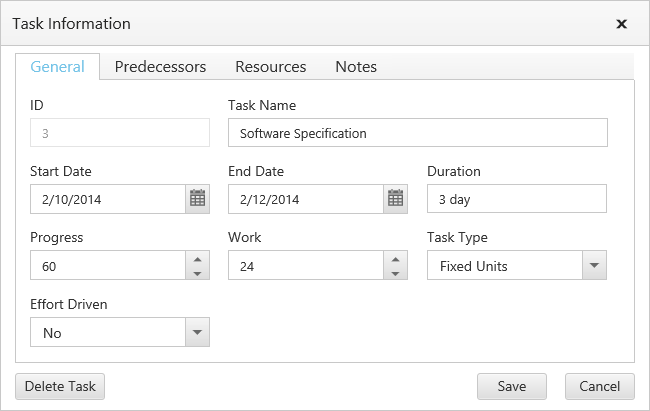
NOTE
By default
cellEditingandnormalediting operations are performed through double-click action and it can be changed to click action by settingbeginEditActionproperty asclick.
Enable Context Menu
You can enable the context menu in Gantt, by setting the enableContextMenu as true.
$("#GanttContainer").ejGantt({
//...
enableContextMenu:true
});The following screen shot displays Gantt chart in which Context menu option is enabled:
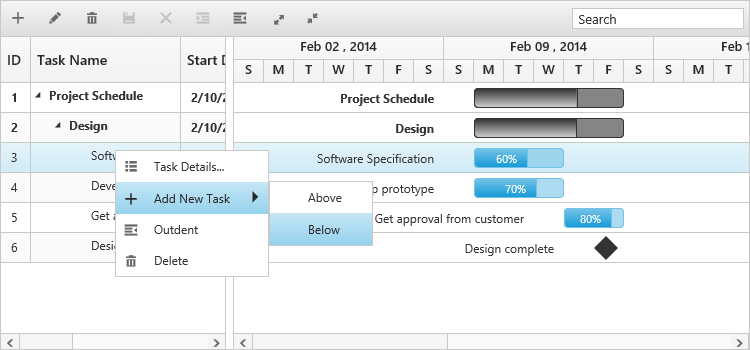
Enable Column Menu
You can enable the column menu in Gantt, by setting the showColumnChooser as true.
$("#GanttContainer").ejGantt({
//...
showColumnChooser:true
});The following screen shot displays Gantt control in which column chooser option is enabled:
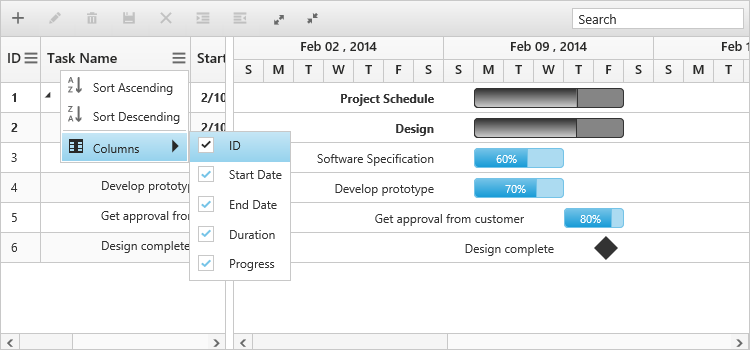
Provide tasks relationship
In Gantt, you have the predecessor support to show the relationship between two different tasks.
- Start to Start (SS) - You cannot start a task until the other task also starts.
- Start to Finish (SF) - You cannot finish a task until the other task finishes.
- Finish to Start (FS) - You cannot start a task until the other task completes.
- Finish to Finish (FF) - You cannot finish a task until the other task completes.
You can show the relationship in tasks, by using the predecessorsMapping property as shown in the following code example.
$("# GanttContainer ").ejGantt({
//...
predecessorMapping: "predecessor"
});The following screenshot displays the relationship between tasks.
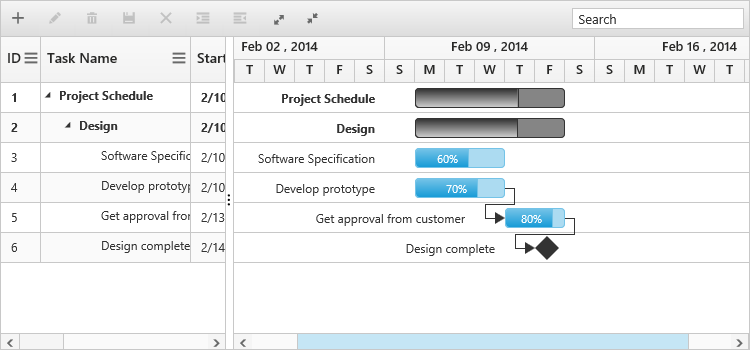
Provide Resources
In Gantt control, you can display and assign the resource for each task. Create a collection of JSON object, which contains id and name of the resource and assign it to the resources property. Then, specify the field name for id and name of the resource in the resource collection to resourceIdMapping and resourceNameMapping options. The name of the field, which contains the actual resources assigned for a particular task in the dataSource is specified using the resourceInfoMapping.
1.Create the resource collection to be displayed in ejGantt.
var projectResources =[{
resourceId: 1,
resourceName: "Project Manager"
},{
resourceId: 2,
resourceName: "Software Analyst"
},{
resourceId: 3,
resourceName: "Developer"
},{
resourceId: 4,
resourceName: "Testing Engineer"
}];2.Initialize the Gantt with resources created in last step.
$("# GanttContainer ").ejGantt({
//...
resourceInfoMapping: "resourceId", //Field name which contains resource details for the task
resourceNameMapping: "resourceName",//resource Name mapping
resourceIdMapping: "resourceId",//resource Id Mapping
resources: projectResources,//resource collection dataSource
});The following screenshot displays resource allocation for tasks in Gantt chart.
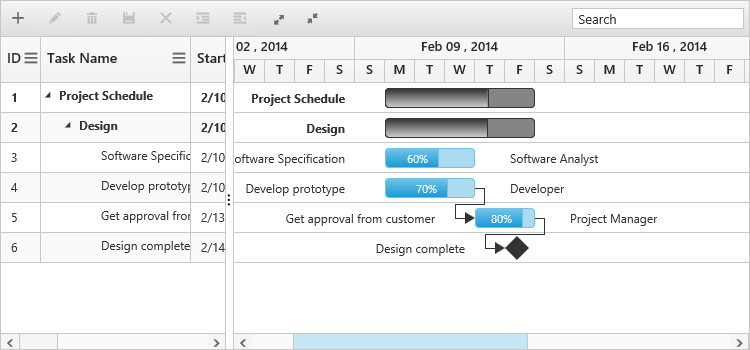
By following these steps, you have learned how to provide data source to Gantt chart, how to configure Gantt to set task relationships, assign resources for each task and add toolbar with necessary buttons.
Highlight Weekend
In Gantt, you can on or off weekends high lighting by setting the highlightWeekEnds as true or false.
$("#GanttContainer").ejGantt({
//...
highlightWeekEnds:false
});The following screen shot displays Gantt chart in which highlight weekends is disabled:
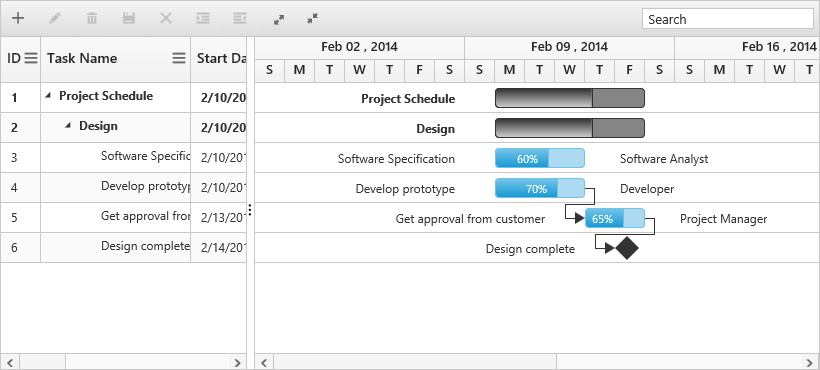
Define dimension of Gantt
By default Gantt control was rendered with 100% width and 450px height, we can define the dimension of Gantt control by using sizeSettings property. Gantt control width and height can be defined by either height and width properties or by defining inline style in Gantt container element. The below code example shows how to define width and height for Gantt control.
<!--<div id="GanttContainer" style="width:700px;height:350px"></div>-->
<div id="GanttContainer"></div>
<script>
$("#GanttContainer").ejGantt({
//...
sizeSettings:{
width: "700px",
height: "350px"
}
});
</script>NOTE
Gantt control will automatically update the width and height value based on container element on window resize action, this can be enabled by setting
isResponsiveproperty astruefor thisheightandwidthvalue will be defined in percentage.
Add notes in tasks
In Gantt, we can add additional information about the tasks, this information can be defined in data source and this field was mapped to Gantt control by using notesMapping property. Notes values can be defined as string or in HTML string format. This notes content was displayed in Notes column and notes value can be updated by using cell editing and dialog editing. The following code example shows how to use the notesMapping property.
var data = [
//...
{
taskID: 4,
taskName: "Develop prototype",
notesContent: "we can show additional information here",
//...
},
//...
];
$("#GanttContainer").ejGantt({
//...
dataSource: data,
notesMapping: "notesContent",
});The below screenshot shows the output of above code example.
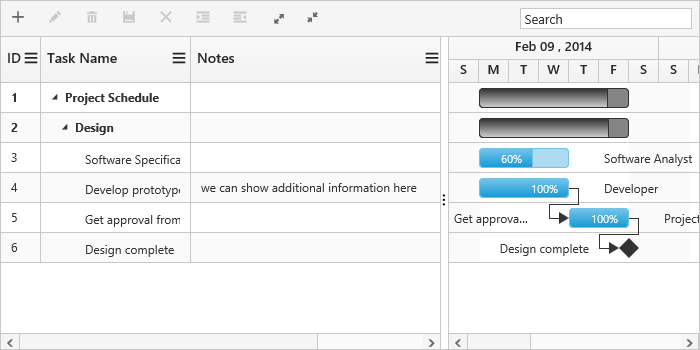
Notes column in Gantt
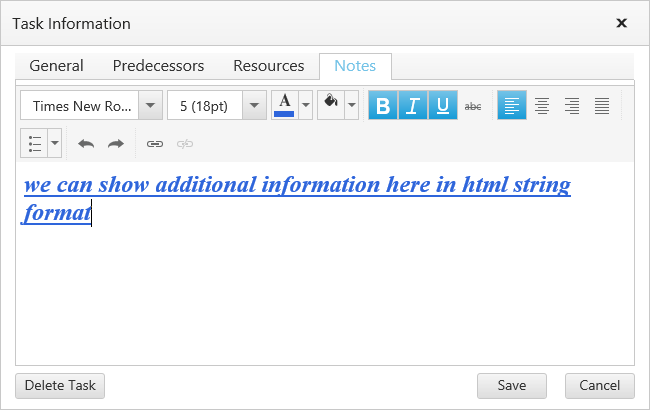
Editing notes in edit dialog
NOTE
Notes value was displayed as plain text in Grid part and also when we edit the notes value by cell editing, value was stored as string value. We can use edit dialog to update the notes value of task in HTML string format.
Milestones in Gantt
Milestones are used to denote the important event/stages in project management. Milestones start date and end date value will be same and duration value was 0. Gantt tasks are rendered as milestone if the task duration value was 0 and we will define task was milestone or not in data source and this field was mapped to Gantt by using milestoneMapping property. The below code example shows how to use this property.
var data = [
//...
{
taskID: 4,
taskName: "Develop prototype",
isMileStone: false,
//..
},
{
taskID: 5,
taskName: "Get approval from customer",
startDate: new Date("02/10/2014"),
endDate: new Date("02/14/2014"),
duration: 2,
isMileStone: true,
},
//...
];
$("#GanttContainer").ejGantt({
//...
dataSource: data,
milestoneMapping: "isMileStone",
});The below screenshot shows the output of above code example.
